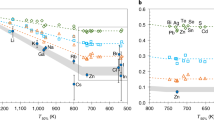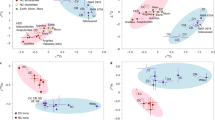Abstract
GEOCHEMISTS have frequently used the abundances of elements in meteorites as a guide to the overall composition of the Earth. The abundances in the chondritic meteorites have been commonly used on the assumption that they represent the closest approach to the composition, for the non-volatile elements, of the primitive unfractionated material in the solar system. Recent work on trace element abundances in chondrites has shown many complications in this picture, and fractionation of the elements, by processes not yet understood, appears to have occurred among the various classes of chondrites. Thus the ordinary chondrites are depleted in the chalco-phile elements such as lead, thallium and bismuth1, compared with the carbonaceous chondrites, which are accordingly thought to be more primitive. Attempts to use the composition of the carbonaceous chondrites are hampered by a lack of data for some trace elements, but the overall similarity in composition of the lithophile elements with that of the high iron group of chondrites enables use to be made of the larger quantity of analytical data existing for that group. The abundances and general geochemistry of the chalcophile elements are too imperfectly known to enable useful calculations to be made at present. In this communication, attention is directed to some problems and consequences of the chondritic Earth model. A fuller discussion, for a total of forty-four elements, will be presented elsewhere2.
This is a preview of subscription content, access via your institution
Access options
Subscribe to this journal
Receive 51 print issues and online access
$199.00 per year
only $3.90 per issue
Buy this article
- Purchase on Springer Link
- Instant access to full article PDF
Prices may be subject to local taxes which are calculated during checkout
Similar content being viewed by others
References
Reed, G. W., Kigoshi, K., and Turkevich, A., Geochim. Cosmochim. Acta, 20, 122 (1960).
Taylor, S. R. (in the press).
Ringwood, A. E., Geochim. Cosmochim. Acta, 15, 257 (1959).
Ringwood, A. E., J. Geophys. Res., 67, 4005 (1962).
Ringwood, A. E., Geochim. Cosmochim. Acta, 20, 241 (1960).
Gast, P. W., J. Geophys. Res., 65, 1287 (1960).
Hurley, P. M., Bull. Geol. Soc. Amer., 68, 379 (1957).
Birch, F., Bull. Geol. Soc. Amer., 69, 483 (1958).
Wasserburg, G. J., MacDonald, G. J. F., Hoyle, F., and Fowler, W. A., Science, 143, 465 (1964).
Lovering, J. F., and Morgan, J. W., J. Geophys. Res. (in the press).
Clayton, D. D., J. Geophys. Res., 68, 3715 (1963).
Taylor, S. R., Geochim. Cosmochim. Acta (in the press).
Ahrens, L. H., ibid., 2, 155 (1952).
Author information
Authors and Affiliations
Rights and permissions
About this article
Cite this article
TAYLOR, S. Chondritic Earth Model. Nature 202, 281–282 (1964). https://doi.org/10.1038/202281a0
Issue Date:
DOI: https://doi.org/10.1038/202281a0
This article is cited by
-
Loss and Fractionation of Noble Gas Isotopes and Moderately Volatile Elements from Planetary Embryos and Early Venus, Earth and Mars
Space Science Reviews (2020)
-
Subcontinental lithospheric mantle origin of high niobium/tantalum ratios in eclogites
Nature Geoscience (2008)
-
Models for the origin and composition of the earth, and the hypothesis of potassium in the Earth's core
Geophysical Surveys (1976)
Comments
By submitting a comment you agree to abide by our Terms and Community Guidelines. If you find something abusive or that does not comply with our terms or guidelines please flag it as inappropriate.



